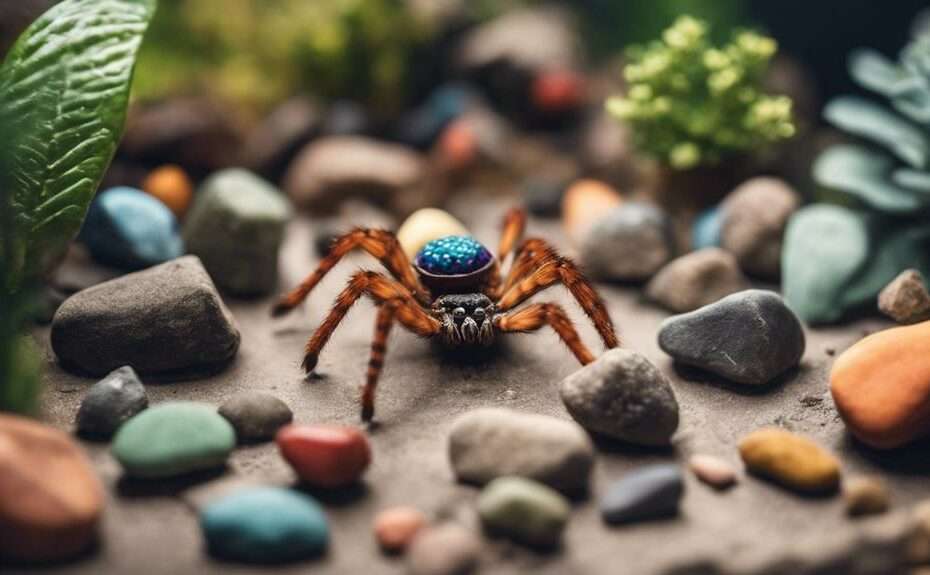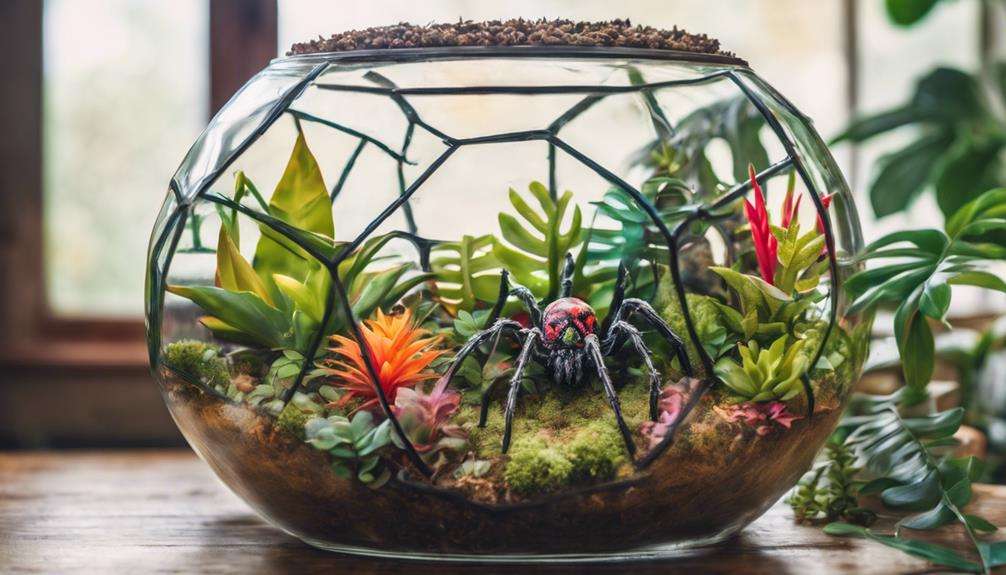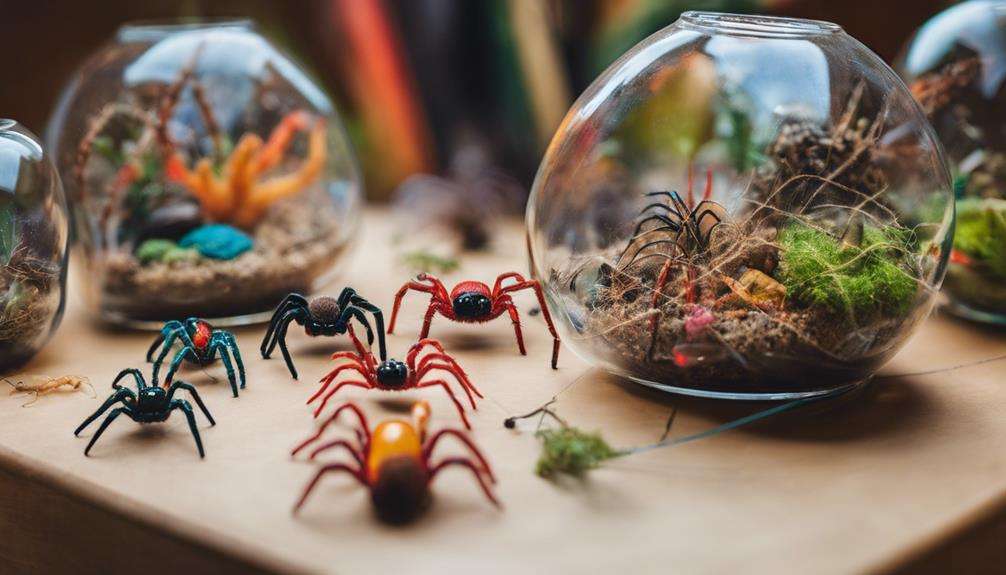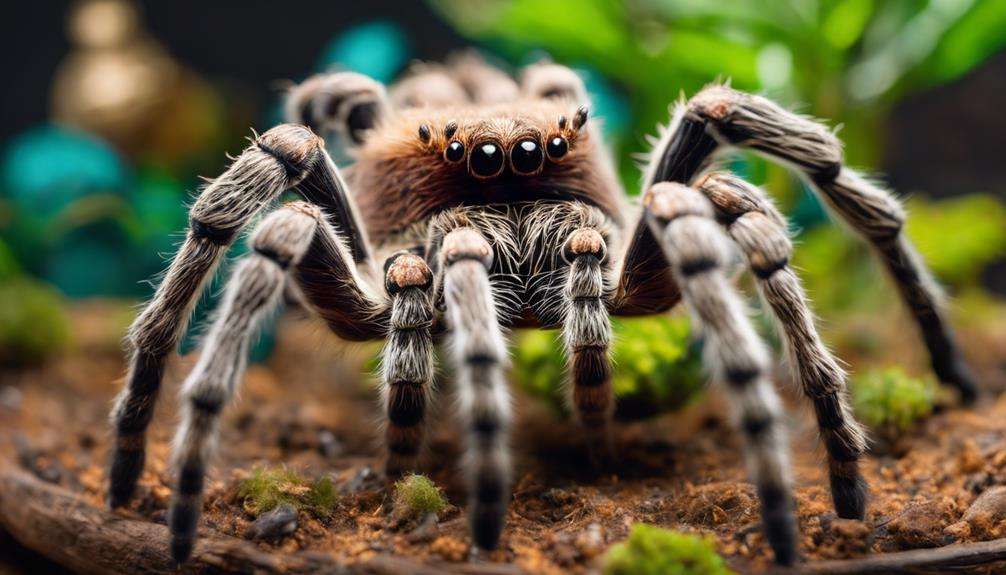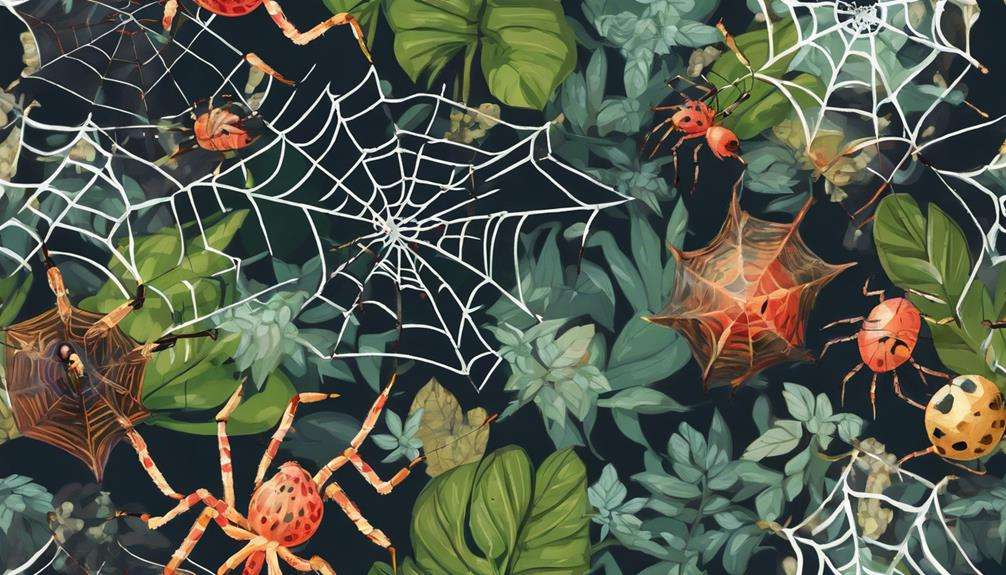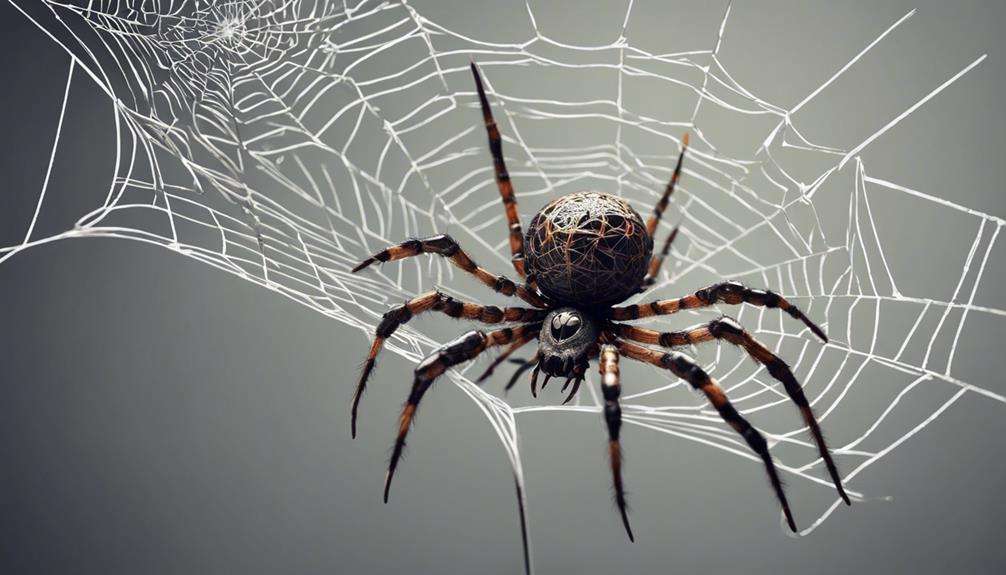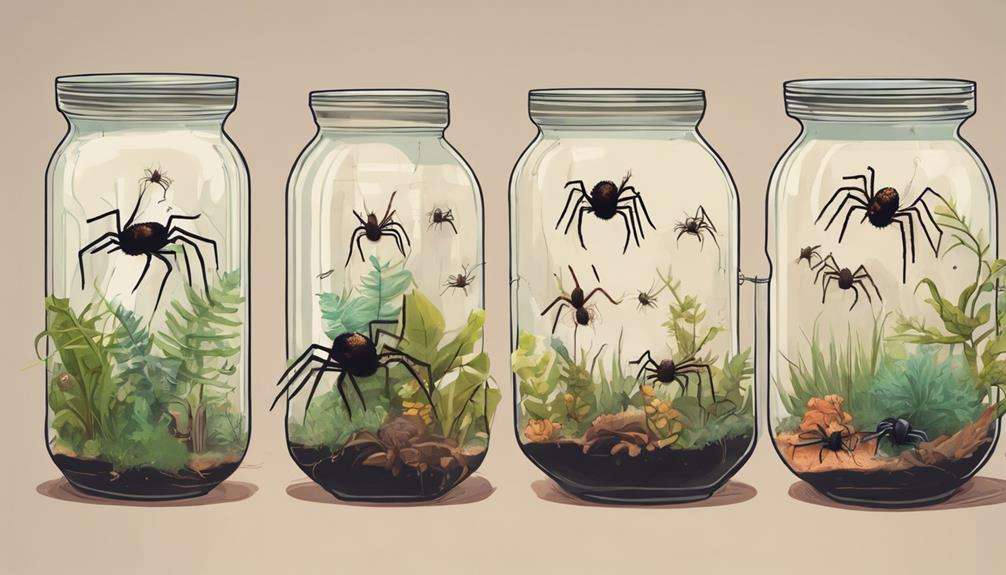Imagine tiny, intricate webs delicately woven in corners, adding a touch of mystery to your living space. These silent inhabitants can provide a fascinating glimpse into the world of arachnids while requiring minimal maintenance.
Curious to learn more about these intriguing creatures that could be the perfect addition to your small space?
Key Takeaways
- Chilean Rose Hair and Mexican Blonde ideal for beginners due to gentle nature and low maintenance.
- Provide warm, humid environment with suitable tank size and hiding spots.
- Specific tarantula species like Brazilian Ebony and Costa Rican Zebra require minimal care and specific environmental conditions.
- Regular research, proper feeding, and cautious handling are essential for general tarantula care in small spaces.
Chilean Rose Hair
The Chilean Rose Hair tarantula, also known as Grammostola rosea, stands out as a favored choice among beginners due to its gentle and docile nature, making it a straightforward pet to handle and care for. This species of pet spider is ideal for those with limited space, as they're low maintenance and thrive in small enclosures. The Chilean Rose Hair tarantula displays a stunning appearance with a pink or blue body and impressive legspans, adding a touch of beauty to any living space. Despite their delicate appearance, these spiders are quite resilient and can live for many years, providing long-term companionship. Their slow growth rate means that they don't require frequent feeding, making them a convenient option for individuals with busy lifestyles.
Moreover, the Chilean Rose Hair tarantulas have a fascinating behavior of rearranging their cage, offering entertainment for their owners. This interactive aspect, combined with their ease of care and gentle temperament, makes them an excellent choice for those new to keeping spiders. Whether you're a seasoned arachnid enthusiast or a beginner looking for a captivating pet, the Chilean Rose Hair tarantula is sure to delight with its grace and charm.
Honduran Curly Hair
If you're considering a Honduran Curly Hair tarantula as a pet, you'll be intrigued by their unique characteristics. These arachnids boast impressive legspans and a fuzzy appearance, adding to their charm.
Understanding their feeding and care requirements, along with creating an ideal living environment, will guarantee a rewarding experience with these gentle spiders.
Unique Pet Characteristics
With its distinctive curly appearance resembling a fuzzy teddy bear, the Honduran Curly Hair tarantula stands out as a unique and enchanting pet choice. This species is known for being gentle and docile, making it an excellent option for those seeking a low-maintenance pet.
Honduran Curly Hair tarantulas have minimal care requirements, ideal for small living spaces. Their popularity in the pet trade is attributed to their calm demeanor and unique physical characteristics. When handled properly, these tarantulas can be fascinating companions for spider enthusiasts.
Their enchanting appearance and easy-going nature make them a delightful addition to any pet lover's collection.
Feeding and Care
Moving on from the unique characteristics of the Honduran Curly Hair tarantula, let's now focus on the essential aspects of feeding and caring for this fascinating arachnid species.
These tarantulas have a diet primarily consisting of live insects such as crickets and mealworms. It's recommended to nourish them 2-3 times a week, adjusting the frequency based on their appetite.
To safeguard their well-being, maintain a warm and humid environment with a temperature range of 75-85°F. Provide a shallow water dish for hydration and keep humidity levels around 70-80%.
Regularly clean the enclosure to remove uneaten prey, molted exoskeletons, and any debris, creating a healthy living space for your Honduran Curly Hair tarantula.
Ideal Living Environment
Maintaining an ideal living environment for your Honduran Curly Hair tarantula is essential for their well-being and longevity. To achieve this, provide a 5 to 10-gallon tank with suitable substrate for burrowing, ensuring a temperature range of 75-85°F and humidity levels between 70-80%.
Offering hiding spots like cork bark or artificial plants creates a secure space for your tarantula to retreat to. Regular misting of the tank and a shallow water dish for hydration are crucial for meeting their moisture needs.
Remember to avoid overhandling your Honduran Curly Hair tarantula to prevent stress and potential harm. By carefully setting up their tank and maintaining the correct conditions, you can ensure a comfortable and thriving environment for your pet spider.
Mexican Blonde
The Mexican Blonde tarantula, scientifically known as Aphonopelma chalcodes, is an excellent choice for beginners interested in pet spiders. Their gentle demeanor, beautiful golden coloration, and manageable size make them a popular option for those with limited space.
When caring for Mexican Blondes, it's important to maintain proper humidity levels and provide a suitable habitat to make sure their well-being.
Mexican Blonde Care
Mexican Blonde tarantulas, also known as Aphonopelma chalcodes, exhibit a striking golden-blonde coloration and impressive legspans, making them visually appealing additions to any collection. These docile creatures are easy to care for, perfect for beginners seeking a low maintenance pet.
Known for their gentle nature, Mexican Blonde tarantulas are unlikely to bite unless guarantee, making them suitable for handling. To confirm their well-being, provide a simple setup with specific humidity requirements. A 5 to 10-gallon tank is sufficient to create a comfortable habitat for these stunning arachnids.
Handling Mexican Blondes
When handling these docile tarantulas, it's important to understand their behavior and apply proper techniques to guarantee their well-being. Mexican Blondes are known for their gentle nature, making them suitable for handling. Their impressive legspan and sleek appearance add to their allure.
To handle Mexican Blondes effectively, it's important to be aware of their docile nature and tendencies. They're popular among tarantula enthusiasts due to their ease of care and calm demeanor. When interacting with Mexican Blondes, make sure to create a calm and quiet environment to prevent stress. Use slow and gentle movements to build trust and avoid sudden actions.
Mexican Blonde Habitat
For best care of your Mexican Blonde tarantula, make sure that its habitat replicates the dry and ground-dwelling conditions they thrive in naturally. Mexican Blonde tarantulas, scientifically known as Aphonopelma chalcodes, are striking in their golden coloration. As a docile and easy-to-care-for species, they're ideal for beginners.
To create a suitable environment, provide a dry habitat with a temperature range of 70-85°F and low humidity levels. Since Mexican Blonde tarantulas are ground-dwelling and burrowing species, it's important to offer a substrate that allows for digging. This setup mimics their natural habitat and promotes their well-being.
Chaco Golden Knee
The Chaco Golden Knee tarantula, known for its stunning golden leg stripes, is a popular choice among spider enthusiasts for its gentle nature and striking appearance.
Grammostola aureostriata, commonly referred to as the Chaco Golden Knee, is a docile species that's easy to care for, making it an ideal option for both beginners and experienced keepers.
These tarantulas require minimal maintenance and feeding, simplifying their care regimen. With impressive legspans and distinct golden leg stripes, they stand out in any collection, adding a touch of visual appeal.
The Chaco Golden Knee is favored for its calm demeanor and striking coloration, characteristics that contribute to its popularity among tarantula enthusiasts.
If you seek a spider with a mesmerizing presence that's easy to handle and maintain, the Chaco Golden Knee is an excellent choice to contemplate for your home.
Brazilian Black
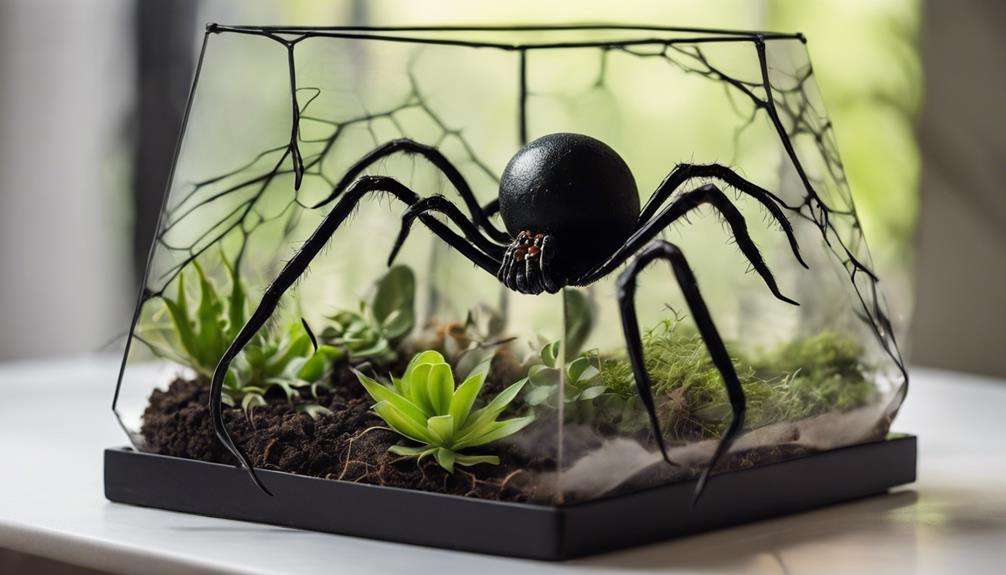
With its sleek ebony appearance and velvety texture, the Brazilian Ebony tarantula, scientifically known as Grammostola pulchra, captivates enthusiasts with its striking features. These docile arachnids are easy to handle, making them a popular choice among both novice and experienced tarantula owners. Brazilian Ebony tarantulas require minimal care and maintenance, which is ideal for those living in compact spaces.
Their impressive legspan, typically ranging from 5 to 6 inches as adults, adds to their allure. Despite their dark coloring, these tarantulas have a calm demeanor and striking looks, making them a fascinating addition to any spider enthusiast's collection. Whether you're drawn to their elegant appearance, their manageable care requirements, or their peaceful nature, the Brazilian Ebony tarantula is sure to captivate anyone looking for a unique and intriguing pet for their small living space.
Costa Rican Zebra
Featuring distinctive white knee stripes, the Costa Rican Zebra tarantula is a visually captivating and hardy arachnid breed known for its low-maintenance care requirements. This species is a great choice for spider enthusiasts due to its hardy nature, rarely falling ill and requiring minimal upkeep. The visually striking appearance of the Costa Rican Zebra tarantula with its white knee stripes adds to its allure as a pet. However, it's important to note that this tarantula has a shy nature and typically prefers not to be handled, opting to observe from the safety of its tank.
To ensure the well-being of your Costa Rican Zebra tarantula, specific care is necessary. Maintaining the correct temperature and humidity levels is important for this species. Providing an environment with temperatures around 75-85°F and a humidity level of 70-80% will help mimic its natural habitat. A tank size of at least 10 gallons is recommended to offer optimal living conditions for your Costa Rican Zebra tarantula.
Mexican Red Knee
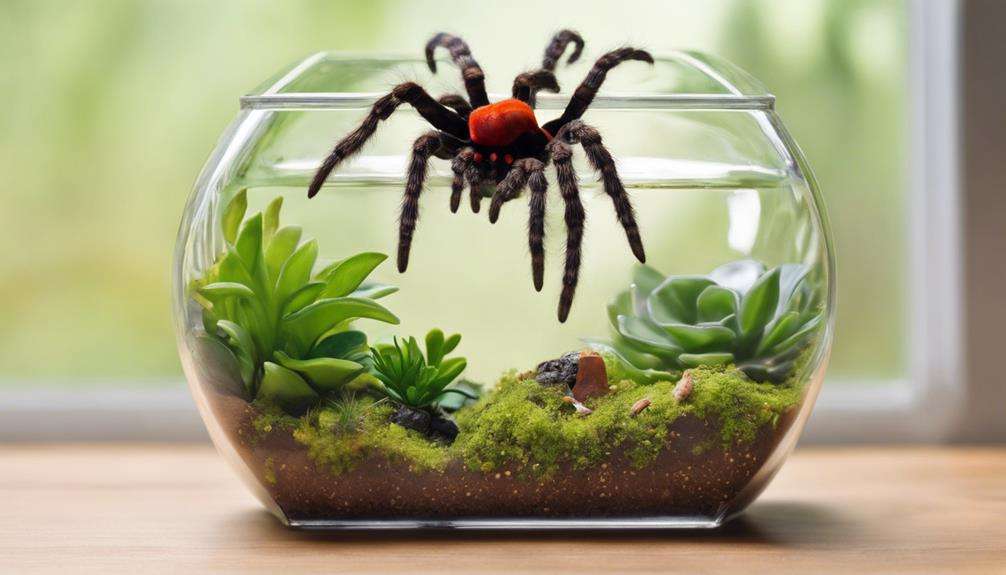
Moving on from the Costa Rican Zebra tarantula, let's explore the Mexican Red Knee tarantula, an enchanting arachnid species known for its vibrant legs and popularity in the pet trade.
The Mexican Red Knee tarantula, scientifically known as Brachypelma hamorii, is native to regions spanning from North Mexico to Panama. Its striking appearance, characterized by orange-red hues on its legs against a dark body, makes it a sought-after choice among tarantula enthusiasts. This species is widely bred due to its colorful legs and ease of care, making it a popular option for beginners in the pet trade.
Mexican Red Knees have a long lifespan and are relatively easy to care for, further adding to their appeal. While capable of biting if provoked, they're generally docile and less stressed during handling compared to other tarantula species, making them suitable for those looking to interact with their pet spider.
Frequently Asked Questions
What Is the Best Small Pet Spider?
Jumping spiders are the best small pet spider. They have teeny fangs, little legs, and adorable arachnids. These compact crawlers make great pocket-sized pets with their mini webs and unique color patterns.
How Much Space Do Pet Spiders Need?
When keeping pet spiders, it's important to understand their habitat requirements. Different species need varying space in their enclosures. Research housing needs to provide adequate room for your spider to move, hunt, and thrive.
What Is the Most Friendliest Spider?
For a friendly spider, consider the Chilean Rose Hair tarantula. Their docile nature and gentle demeanor make them ideal for beginners. With minimal care, these spiders are perfect for small spaces. Handle with care for bonding opportunities.
Can You Keep Small Spiders as Pets?
You can definitely keep small spiders as pets! They offer a unique pet experience with low maintenance needs. Observing their behavior, feeding them, and setting up suitable habitats are key aspects of spider care.
Conclusion
You have now been introduced to seven fascinating pet spiders that are perfect for small spaces.
Did you know that the Chilean Rose Hair tarantula can live up to 20 years in captivity, making it a long-term and rewarding companion for spider enthusiasts?
With their unique characteristics and low maintenance requirements, these spiders can bring joy and intrigue into your home while thriving in a compact environment.
Consider adding one of these amazing arachnids to your pet collection today!
